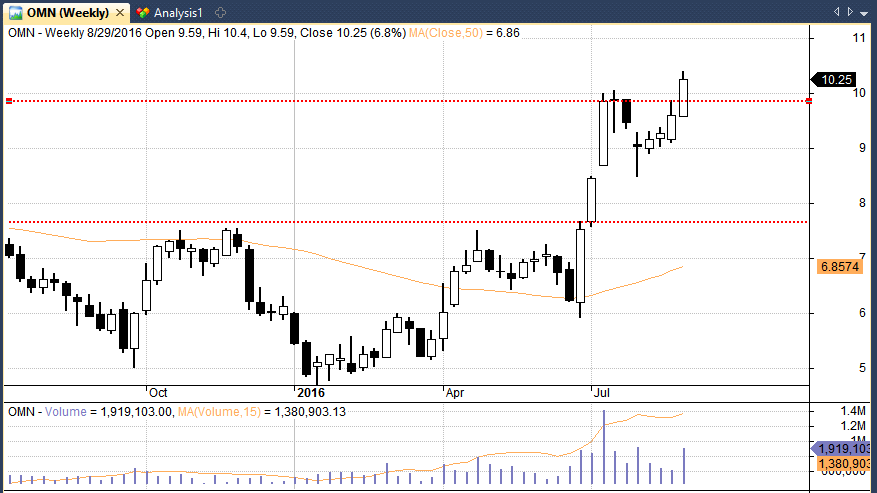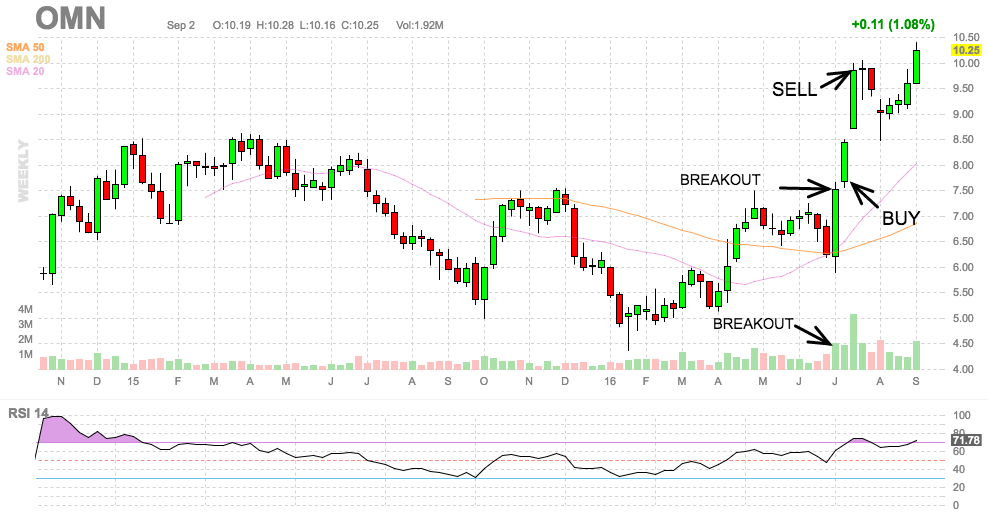I wanted to write an article to explain some of the processes I go through when trading US stocks. Since August was a particularly quiet month with only a few winners I have decided to go back to a trade I made in July in Omnova Solutions ($OMN).
This was also one of my best trades of the year and which I also reported in another blog post.
I purchased OMN on the 5th July 2016 at a price of $7.68 per share and sold two weeks later at $9.85 per share – an impressive move capturing 28% in a short amount of time.

In truth, most trades do not work out this well but I wanted to write this article as it will give you an understanding about how I trade and how I approach the markets.
Multi-System Approach
My approach to the markets is to rotate through a handful of different trading systems that I have designed and tweaked over time.They are mostly based on special situations, trend following concepts or price action strategies.
These strategies primarily focus on S&P 1500 or Russell 3000 stocks and are all end-of-day strategies.
This means I mostly trade on the open or the close and can use market orders (which I find also helps to avoid the bid-ask spread).
The systems share different characteristics which means they can be used together and this can help smooth overall exposure and drawdown.
Omnova Solutions (OMN)
One of the systems I keep track of identified Omnova Solutions as a possible swing trade for the week of 4/7/2016.
As you can see from the chart, the stock had just broken out to a new yearly high and this was also accompanied by a sudden upsurge in volume. In fact, the weekly volume accompanying this move was the most since 2012.

Since the stock also met my criteria for liquidity and was a member of the S&P 1500 I then turned to the recent news stories to get an idea why the stock had rallied.
Bringing the stock up on Finviz Elite I was able to check the recent headlines and discovered that OMN was advancing as a result of a strong earnings beat.
In fact, the company had just reported 2nd quarter financial earnings way above expectations.
Although reported headline revenue was not as impressive, company guidance was much more positive and analyst upgrades were also supporting the new outlook.
Because of this I placed an order to buy OMN on the next market open and got filled at the opening price of $7.68. I then exited the trade two weeks later on the close (again using a market order) in accordance with the exit rules of the strategy.
As you can see from the chart posted above, the stock has since moved past my exit price but I am more than happy with the prior result.
Strategy Formulation
As I mentioned above, this strategy is just one of a handful of strategies I keep track of. The origins of the strategy can be traced to a resource called Quantpedia which I often use to find new trading and investing ideas.
I then used Amibroker to make the system my own. I introduced new elements and back-test the system on my own data so that I could be more confident in the analysis. I then used Finviz Elite to get a better idea of the company, look more closely at the business and to better inform the trade.
I implemented the trade with Interactive Brokers and then kept track of the results using a spreadsheet in Google Drive.
In simple terms, then, this process can be described in the following steps:
• Idea formulation using Quantpedia
• Back-testing and customisation with Amibroker
• Human analysis with Finviz Elite
• Execution with Interactive Brokers
• Trade analysis with Google Drive
Some Things I Did Not Do
I think this process tells you a lot about how I approach the markets. I like to rotate and combine strategies so this is just one of a handful of systems I use.
I also like to combine a certain amount of human discretion alongside the mechanical process.
But as I said in another article, it is important to understand the things that are not done. Since learning what not to do can be as useful as learning what to do.
So here are some things I did not do:
• I did not use a tight stop loss.
• I did not use a profit target.
• I did not trade in and out.
• I did not override the system.
• I did not trade on margin. (I entered a cash position worth 10% of my account in line with my system rules).
By not doing the things above I was able to avoid common trading mistakes and stick to my trading plan. In fact, if I had done some of the things mentioned above I would not have made anywhere near the same return from the trade.
All in all, the process was extremely simple to execute. All the hard work was done during the idea generation and back-testing phase. This takes away a lot of the stress and allows clean, straightforward trading.

Thanks for the breakdown Joe. This is a great example that goes to show sticking to your plan can yield profitable results. And I especially appreciated the emphasis on things you did NOT do for this trade. That in itself is extremely illustrative.
Thanks again and hope you have a great weekend,
Jay
Thanks Jay, I’m glad you found it helpful. I see from your website that you are also a fan of Finviz. Great work, it is such a great tool for stock traders isn’t it.
Cheers